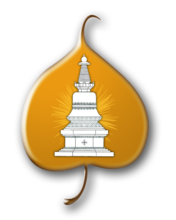We will celebrate Shakyamuni Buddha’s Birth, Enlightenment, and Passing into Parinirvana this year on Saturday, May 21 (known in Tibetan as Saka Dawa). The karmic effects of all actions performed on this day are multiplied exponentially, according to Lama Zopa Rinpoche, citing the Vinaya text Treasure of Quotations and Logic.
Kadampa Center will offer two opportunities on this day that are especially beneficial to newcomers to Buddhism. We are incredibly fortunate to have a qualified teacher who is happy to offer these two sets of vows when students request them.
The first of these is taking the Eight Mahayana Precepts. https://kadampa-center.org/eight-mahayana-precepts These are 24-hour vows that are taken just before dawn. They are vows not to kill, steal, lie, take intoxicants, engage in sexual activity, eat at the wrong times, sit on high thrones or wear jewelry. It is incredibly powerful to live in these vows even for a single day. The first time you take these vows it must be from a qualified master. Geshe Gelek will offer the precepts on Saka Dawa if students request him to do so. If you would like to take precepts from Geshe-la, please register by emailing Patrick McGinity You must register for precepts by Sunday, May 15.
If you are planning to attend the Light of the Path Retreat in August, this is a good opportunity to take these vows from a qualified master. Each day of the retreat begins with the precepts, but if you have not taken them from a master, you may miss out on this aspect of retreat.
Another wonderful opportunity for newer students of Dharma is the chance to take refuge and lay vows. Geshe Gelek will offer refuge and lay vows if students request it.
When we take refuge in the Buddha with a spiritual master, we are embracing the Buddhist path as our primary spiritual practice. Lama Yeshe said, “Buddhist refuge is a process of turning inward that begins with our discover of our own unlimited potential as human beings.” If you wish to take refuge with Geshe-la, you must register by Wednesday, May 18.
Our schedule for Saka Dawa:
5:30 am The Eight Mahayana precepts STARTS PROMPTLY AT 5:30 If you haven’t taken the precepts previously and wish to do so, please contact Patrick McGinity
Followed by light breakfast
7 am Group reading of the Diamond Cutter Sutra and other practices
The gompa will be open all day for personal practice
4:30 pm Set up offerings for Tara practice This may happen earlier in the day if people are present and interested in helping
6 pm Refuge and Lay vows with Geshe Gelek
7 pm The Practice of Tara that Fulfills All Wishes
Click here to sponsor Tara Practice.
We will have a group reading of the Diamond Cutter (Vajra Cutter) Sutra as one of our practices that morning. Geshe Gelek recommends that we begin a daily reading of any sutra on the first day of the month of Saka Dawa, May 13, in preparation for the group reading. You can download a copy of this sutra from FPMT.
Because Saka Dawa is a merit-multiplying day, it’s an auspicious time for any practice, individual as well as group, and to make offerings of any kind, including financial offerings to the sangha (see more at https://kadampa-center.org/sangha-support-and-offerings), lights to the altar or stupa or flowers to the altar or stupa.
Sponsor lights or flowers:

